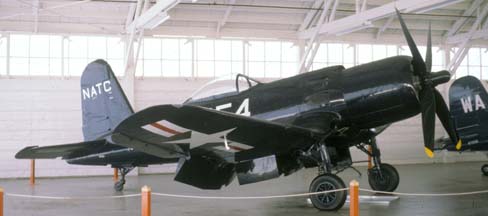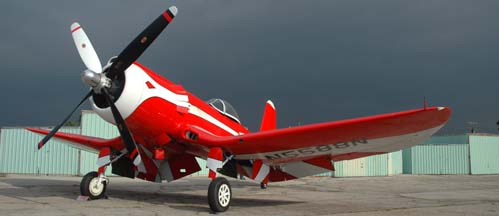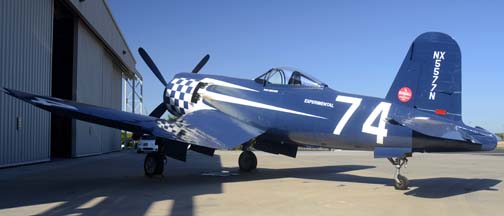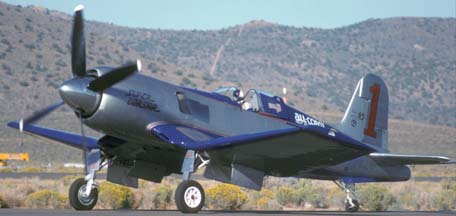 (Download a higher resolution picture by clicking on any
picture below.)
(Download a higher resolution picture by clicking on any
picture below.)
Corsairs with Four-bank Radials |
 (Download a higher resolution picture by clicking on any
picture below.)
(Download a higher resolution picture by clicking on any
picture below.)
During World War II and again in the 1980s, engineers sought to increase the performance of the Vought F4U Corsair by installing a 4,360-cubic-inch, 28-cylinder engine in place of the standard 2,800-cubic-inch, 18-cylinder engine. The Pratt & Whitney R-4360 radial engine generated nearly twice the horsepower of the Pratt & Whitney R-2800 that equipped the standard Corsair. The R-4360 is the most powerful reciprocating engine ever installed in a single engine airplane.
In order to combat the threat of Japanese kamikaze pilots in World War II, the R-4360 radial engine was mated to the Vought F4U Corsair to produce a specialized fighter with an extremely high rate of climb.
When the F2G went into production, it was referred to as Corsair, not Super Corsair.
In 1982 a standard F4U Corsair was modified with an R-4360, clipped wings, and a cut down cockpit canopy to compete at the Reno Air Races as the Super Corsair. It won the 1985 Gold Unlimited Race at Reno, setting a new race record.
Pratt & Whitney tested the compatability of the R4360 on F4U-1 Corsair, BuNo 02460. Goodyear modified two FG-1s, BuNo 13471 and BuNo 13472, to test the R4360 installation. Those Corsairs retained the FG-1 cockpit and turtle deck. Goodyear modified two FG-1s , BuNo 14091 and BuNo 14092, to evaluate the installation of a Republic P-47 teardrop canopy.
The production program for the R4360 equipped Corsair was assigned to the Goodyear Aircraft Company of Akron Ohio which manufactured the F4U under license as the FG. The new Corsair variant received the designation F2G.
The production F2G has a tear-drop canopy in place of the original Corsair cockpit and turtle deck. The vertical stabilizer of the F2G is 12 inches taller than on the standard Corsair and has an auxiliary rudder to counteract engine torque.
The rate of climb of the F2G was 7,000 feet per minute, twice the rate of climb of the standard Corsair and higher than the jet fighters of the time.
Only fifteen F2Gs were built: five pre-production XF2Gs (BuNos 14691 - 14695), five F2G-1s (BuNos 88454 - 88458), and five F2G-2s (BuNos 88459 - 88463). F2G-1s were intended to operate from land bases, not aircraft carriers. They had a manually operated wing fold mechanism and no tail hook. They were equipped with a fourteen-foot diameter propeller. F2G-2s were built with hydraulically powered wing fold mechanisms and tail hooks for carrier operations. Their propellers were thirteen feet in diameter.
Five F2Gs were converted to racing planes after the war: two pre-production XF2Gs (BuNos 14693 and 14694), two F2G-1s (BuNos 88457 and 88458), and one F2G-2 (88463).
Two F2Gs still survive; one F2G-1 in stock military configuration (BuNo 88454) and one of the racing F2Gs BuNos 88458 and 88463).
Ben McKillen Jr. piloted Race #57 to third place in the 1949 Thompson Trophy Race at a speed of 387.589 miles per hour, behind Cook Cleland in F2G-1 N5590N Race #94 (397.071 miles per hour) and Ron Puckett in F2G-1 N91092 Race #18 (393.527 miles per hour). McKillen won the 1949 Tinnerman Trophy Race in Race #57 at a speed of 386.069 miles per hour.
From 1950 to 1996, NX5588N passed through the hands of several owners, deteriorating progressively over years of outdoor storage. Robert J. Odegaard of Kindred, North Dakota acquired it on March 2, 1996. He performed a meticulous restoration of its appearance at the 1949 air races and returned it to airworthy condition in 1999.
Cook Cleland won the 1947 Thompson Trophy in it at 396.131 miles per hour. In 1949 Dick Becker qualified it for the Thompson Trophy Race at 414 miles per hour, but stripped the propeller reduction gear and did not race. In 1950 it was acquired by Walter Soplata and stored with his aircraft collection in Newberry, Ohio.
Bob Odegaard began its restoration for static display at the Crawford Auto Aviation Museum in Cleveland, Ohio in 2000, but funding dried up and it was purchased by Tom Ungurean. It has been restored in the blue and white colors that it wore at the 1949 Thompson Trophy Race. It was displayed at the EAA show in Oshkosh in July 2011 and at the Reno Air Races in September.
Tragically, Bob Odegaard and Race 74 were lost in a crash at Barnes County Municipal Airport in North Dakota on September 7, 2012 while preparing for the Wings and Wheels Airshow.
See the location where I photographed F2G-2 BuNo 88463 NX5577N in Google Earth.
The origins of Super Corsair's airframe have been lost. The unidentifed F4U-1D served as a movie prop for a number of years before being added to the collection of the Air Museum in Ontario, California in 1959. Its fuselage was displayed at the museum through the 1960s.
James Maloney and the Planes of Fame Air Museum of Chino, California registered the Super Corsair as NX31518 in 1982 and raced it as Race #1. Steve Hinton and Fighter Rebuilders acquired it in 1984. Hinton won the 1985 Gold Unlimited Race at Reno in Race #1 at a speed of 438.186 miles per hour, establishing a new race speed record.
The Super Corsair caught fire and crashed at the Phoenix 500 Unlimited Air Race on March 19, 1994. Pilot Kevin Eldridge struck the left horizontal stabilizer and was seriously injured as he exited the flaming airplane.
- advertisement - You can buy a 2020 calendar
featuring my photographs of Corsairs with Four Bank Radials. A dozen photos of four Corsairs equipped with Pratt & Whitney R-4360 Wasp Major twenty-eight-cylinder, four-bank radial engines, three Goodyear F2Gs and the Super Corsair racing plane. F2G-1 N4324 remains in stock configuration. F2G-1 N5588N and F2G-2 NX5577N were converted for racing in the post-war Thompson Trophy Races. The Super Corsair racing plane N51318 was converted from a standard F4U in the 1980s. This calendar has been updated with photos from the first reunion of two of Cook Cleland's racing F2Gs in sixty-two years at the Arizona Wing of the Commemorative Air Force on December 27, 2011.
- advertisement - Send a message to Brian
. Goodyear F2G Racer Reunion at Falcon Field, December 27, 2011

Two Goodyear F2G Corsairs that competed in the 1949 Thompson Trophy Race were reunited for the first time in sixty-two years at the Commemorative Air Force ramp at Falcon Field, Mesa, Arizona on December 27, 2011. F2G-1 N5588N Race 57 and F2G-2 N5577N Race 74 were brought together for an air-to-air photo shoot over the Superstition Mountains. Race 57 has just undergone ten and a half months of restoration.
F2G-1 BuNo 88454 N4324
 F2G-1, BuNo 88454 was the first production F2G. It carries Goodyear construction number 6163. It was tested at Naval Air Station Patuxent River and Naval Air Station Norfolk from 1945 to 1948. The Navy placed it in a storage container and left it there for eighteen years. In 1966, it was transferred to the Bradley Air Museum at Windsor Locks, Connecticut. Walter Olrich of Norfolk, Virginia registered it as N4324 in 1972, intending to race it as Race #50. The Navy objected and retrieved the F2G-1. It was displayed at the United States Marine Corps Museum at Quantico Virginia in 1974. Doug Champlin and Windward Aviation of Oklahoma acquired it in 1974. It was displayed at the USS Intrepid Museum in New York in 1976. Champlin moved it to the Champlin Fighter Museum in Mesa, Arizona in 1978. It, and most of the Champlin Fighter Collection, are now displayed at the Museum of Flying in Seattle, Washington.
F2G-1, BuNo 88454 was the first production F2G. It carries Goodyear construction number 6163. It was tested at Naval Air Station Patuxent River and Naval Air Station Norfolk from 1945 to 1948. The Navy placed it in a storage container and left it there for eighteen years. In 1966, it was transferred to the Bradley Air Museum at Windsor Locks, Connecticut. Walter Olrich of Norfolk, Virginia registered it as N4324 in 1972, intending to race it as Race #50. The Navy objected and retrieved the F2G-1. It was displayed at the United States Marine Corps Museum at Quantico Virginia in 1974. Doug Champlin and Windward Aviation of Oklahoma acquired it in 1974. It was displayed at the USS Intrepid Museum in New York in 1976. Champlin moved it to the Champlin Fighter Museum in Mesa, Arizona in 1978. It, and most of the Champlin Fighter Collection, are now displayed at the Museum of Flying in Seattle, Washington.
F2G-1 BuNo 88458 NX5588N
 F2G-1 BuNo 88458 was the fifth F2G-1. It carries Goodyear construction number 6167. It was tested at Port Columbus, Ohio and Naval Air Station Patuxent River from October 1945 to July 1946. The Navy retired it in January 1948. Cook Cleland bought it for spare parts, but then registered it as NX5588N. That was the same registration worn by Cleland's F2G-1 BuNo 88457, which crashed at the 1947 Thompson Trophy Race. NX5588N raced as Race #57 in the 1949 Thompson and Tinnerman Trophy Races at Cleveland, Ohio.
F2G-1 BuNo 88458 was the fifth F2G-1. It carries Goodyear construction number 6167. It was tested at Port Columbus, Ohio and Naval Air Station Patuxent River from October 1945 to July 1946. The Navy retired it in January 1948. Cook Cleland bought it for spare parts, but then registered it as NX5588N. That was the same registration worn by Cleland's F2G-1 BuNo 88457, which crashed at the 1947 Thompson Trophy Race. NX5588N raced as Race #57 in the 1949 Thompson and Tinnerman Trophy Races at Cleveland, Ohio.
F2G-2 BuNo 88463 NX5577N
 Bob Odegaard has restored Cook Cleland's former racing mount, F2G-1 BuNo 88463 N5577N Race #74 to airworthy condition for Tom Ungurean of Ohio.
Bob Odegaard has restored Cook Cleland's former racing mount, F2G-1 BuNo 88463 N5577N Race #74 to airworthy condition for Tom Ungurean of Ohio.
F4U Super Corsair
 The R4360 equipped Super Corsair racing plane was not a Goodyear F2G. In 1982 a standard F4U Corsair was modified with an R4360, clipped wings, and a cut down cockpit canopy to compete at the Reno Air Races.
The R4360 equipped Super Corsair racing plane was not a Goodyear F2G. In 1982 a standard F4U Corsair was modified with an R4360, clipped wings, and a cut down cockpit canopy to compete at the Reno Air Races.
Corsairs with Four Bank Radials
2020 Calendar
 Put a copy of the Corsairs with Four Bank Radials: 2020 Calendar in your Lulu.com shopping cart for $14.95.
Put a copy of the Corsairs with Four Bank Radials: 2020 Calendar in your Lulu.com shopping cart for $14.95.